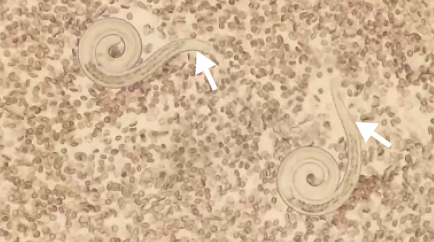Subcutaneous ivermectin for the treatment of the hyperinfection syndrome by Strongyloides stercoralis
Abstract
Strongyloidiasis is a disease caused by the nematode Strongyloides stercoralis that is endemic in rural regions in tropical and subtropical countries. Immunosuppressed patients have an increased risk of infection by this parasite and are at risk of developing a hyperinfection syndrome which involves a higher risk of death. The syndrome is treated with ivermectin, however, there is no parenteral presentation of this medication for human use in Colombia or the world, which is an important problem in patients who have compromised enteral absorption, for instance, those with intestinal obstructions.
We present a case of hyperinfection syndrome by Strongyloides stercoralis in Colombia, which was treated with subcutaneous ivermectin. Our purpose is to encourage pharmacokinetic and pharmacodynamic studies to establish this route of administration in the future as an alternative for those patients who have a high risk of therapeutic failure with the oral route.
Downloads
References
Kassalik M, Mönkemüller K. Strongyloides stercoralis hyperinfection syndrome and disseminated disease. Gastroenterol Hepatol. 2011;7:766-8.
Greaves D, Coggle S, Pollard C, Aliyu SH, Moore EM. Strongyloides stercoralis infection. BMJ. 2013;347:f4610. https://doi.org/10.1136/bmj.f4610
Roxby AC, Gottlieb GS, Limaye AP. Strongyloidiasis in transplant patients. Clin Infect Dis. 2009;49:1411-23. https://doi.org/10.1086/630201
Marcos LA, Terashima A, Dupont HL, Gotuzzo E. Strongyloides hyperinfection syndrome: An emerging global infectious disease. Trans R Soc Trop Med Hyg. 2008;102:314-8. https://doi.org/10.1016/j.trstmh.2008.01.020
Hernández-Chavarría F. Strongyloides stercoralis: un parásito subestimado. Parasitol Día. 2001;25:40-9. https://doi.org/10.4067/S0716-07202001000100008
Schär F, Trostdorf U, Giardina F, Khieu V, Muth S, Marti H, et al. Strongyloides stercoralis: Global distribution and risk factors. PLoS Negl Trop Dis. 2013;7:e2288. https://doi.org/10.1371/journal.pntd.0002288
Puthiyakunnon S, Boddu S, Li Y, Zhou X, Wang C, Li J, et al. Strongyloidiasis—an insight into its global prevalence and management. PLoS Negl Trop Dis. 2014;8:e3018. https://doi.org/10.1371/journal.pntd.0003018
Buonfrate D, Mena MA, Angheben A, Requena-Méndez A, Muñoz J, Gobbi F, et al. Prevalence of strongyloidiasis in Latin America: A systematic review of the literature. Epidemiol Infect. 2015;143:452-60. https://doi.org/10.1017/S0950268814001563
Center for Disease Control and Prevention. Strongyloidiasis. Fecha de consulta: 20 de febrero de 2019. Disponible en: https://www.cdc.gov/parasites/strongyloides/index.html
Llagunes J, Mateo E, Peña JJ, Carmona P, Andrés J. Hiperinfección por Strongyloides stercoralis. Med Intensiva. 2010;34:353-6. https://doi.org/10.1016/j.medin.2009.06.006
Lim S, Katz K, Krajden S, Fuksa M, Keystone JS, Kain KC. Complicated and fatal Strongyloides infection in Canadians: Risk factors, diagnosis and management. CMAJ. 2004;171:479-84. https://doi.org/10.1503/cmaj.1031698
Segarra-Newnham M. Manifestations, diagnosis, and treatment of Strongyloides stercoralis infection. Ann Pharmacother. 2007;41:1992-2001. https://doi.org/10.1345/aph.1K302
Barrett J, Broderick C, Soulsby H, Wade P, Newsholme W. Subcutaneous ivermectin use in the treatment of severe Strongyloides stercoralis infection: Two case reports and a discussion of the literature. J Antimicrob Chemother. 2016;71:220-5. https://doi.org/10.1093/jac/dkv315
Chiodini PL, Reid AJ, Wiselka MJ, Firmin R, Foweraker J. Parenteral ivermectin in Strongyloides hyperinfection. Lancet. 2000;355:43-4 https://doi.org/10.1016/s0140-6736(99)02744-0
Zeitler K, Jariwala R, Restrepo-Jaramillo R, Kapadia S, Casanas B, Sriaroon C, et al. Successful use of subcutaneous ivermectin for the treatment of Strongyloides stercoralis hyperinfection in the setting of small bowel obstruction and paralytic ileus in the immunocompromised population. BMJ Case Rep. 2018;2018:bcr-2017-223138. https://doi.org/10.1136/bcr-2017-223138
Some similar items:
- Claudia M.E. Romero-Vivas, Luis Eduardo Castro, Lila Visbal, Ana María Santos, Esther Díaz, Cutaneous myiasis by Cochliomyia hominivorax (Coquerel) (Díptera Calliphoridae) in Hospital Universidad del Norte, Soledad, Atlántico , Biomedica: Vol. 29 No. 1 (2009)
- Carlos Pérez, Yoanet Solías, Gerzaín Rodríguez, Diffuse cutaneous leishmaniasis in a patient with AIDS , Biomedica: Vol. 26 No. 4 (2006)
- Leonardo Elías Ordóñez, Esther Sofía Angulo, Efficacy of ivermectin in the treatment of children parasitized by Strongyloides stercoralis. , Biomedica: Vol. 24 No. 1 (2004)
- María Eugenia Castaño, Mauricio Sarmiento, Lázaro Vélez, Juan Carlos González, Francisco Cuéllar, María Teresa Rugeles, Victoria Inés Bedoya, Presence of circulating cytomegalic cells in HIV negative immunosuppressed individuals following cytomegalovirus infection. , Biomedica: Vol. 25 No. 1 (2005)
- Ana Luz Galván, Sonia del Pilar Agudelo, Juan Gonzalo Restrepo, Fabiola Toro, Luisa Alejandra Galviz, Jorge Botero, Cyclosporine A effect in mice C57BL/6 infected with Encephalitozoon intestinalis. , Biomedica: Vol. 26 No. 1 (2006)
- Martín Dadé, Martín Daniele, Nora Mestorino, Evaluation of the toxic effects of doramectin, ivermectin and eprinomectin against Triatoma infestans using a rat model , Biomedica: Vol. 37 No. 3 (2017)
- Kateir Contreras, María José Vargas, Paola García, Camilo A. González, Patricia Rodríguez, Camilo Castañeda-Cardona, Margarita Otálora-Esteban, Diego Rosselli, Cost-effectiveness of two prevention cytomegalovirus infection schemes in renal transplant patients at intermediate risk in Colombia , Biomedica: Vol. 38 No. 1 (2018)
- John Fredy Nieto-Ríos, Douglas Ramón Villafañe-Bermúdez, Gustavo Adolfo Guerrero-Tinoco, Isabel Cristina Ramírez-Sánchez, Lina María Serna-Higuita, Arbey Aristizábal-Alzate, Catalina Ocampo-Kohn, Gabriel Varela, Gustavo Zuluaga-Valencia, Brain abscess caused by Cladophialophora bantiana after renal allograft loss: A case report , Biomedica: Vol. 39 No. Supl. 2 (2019): Enfermedades transmisibles en el trópico, agosto
- Lina Echeverri-Toro, Andrés Arango, Sigifredo Ospina, Carlos Agudelo, Bordetella bronchiseptica recurrent bacteraemia in a patient with bone marrow transplantation , Biomedica: Vol. 35 No. 3 (2015)
- Katherine Márquez, Diego Andrés Rodríguez, Luis Alfonso Pérez, Mauricio Duarte, Luis Augusto Zárate, Epidermolysis bullosa with pyloric atresia: Report of two cases in consecutive siblings , Biomedica: Vol. 41 No. 2 (2021)

| Article metrics | |
|---|---|
| Abstract views | |
| Galley vies | |
| PDF Views | |
| HTML views | |
| Other views | |

























